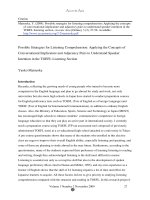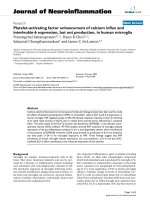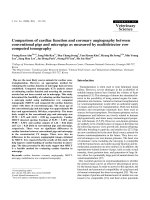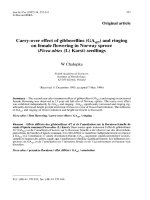The phenomena of charge inversion and effective attraction between the spherical macromolecules in electrolyte solvent
Bạn đang xem bản rút gọn của tài liệu. Xem và tải ngay bản đầy đủ của tài liệu tại đây (659.22 KB, 0 trang )
42
Ha Noi Metroplolitan University
THE PHENOMENA OF CHARGE INVERSION
AND EFFECTIVE ATTRACTION BETWEEN
THE SPHERICAL MACROMOLECULES IN ELECTROLYTE SOLVENT
Nguyen Vu Nhan1, Nguyen Viet Duc2, Toan T. Nguyen2
1
Hanoi Metropolitan University
2
Key Laboratory for Multiscale Simulation of Complex Systems,
VNU University of Science, Vietnam National University
Abstract: The phenomena of charge inversion and effective attraction between the like charged spherical macromolecules in electrolyte solvent has been studied by using
Poisson - Boltzmann mean-field theory, alongside the assumption that counterions
condense on the surface of macromolecules to form a strongly correlation liquid. This
oversimplified model is able to capture many important features of these phenomena,
provide essential understanding of electrostatics in strong interaction regime in
biological and soft matter systems.
Keywords: Charge inversion, like-charged attraction, polyelectrolyte solution, Poisson Boltzmann equation, biological macromolecule.
Email:
Received 16 October 2019
Accepted for publication 15 November 2019
1. INTRODUCTION
In recent years, the there are many researches on physical properties of biological and
soft maters macro-molecules, such as colloidal particles, vesicles, micelles, proteins,
DNA… Insightly knowledge about structure and also interaction of biological molecules is
essential to understand biological processes [1]. Most of these systems function in aqueous
solution in the presence of many electrolytes such as NaCl, MgCl2… Standard theoretical
and computational approaches to understand the electrostatics of these system has been
mostly based on the Poisson-Boltzmann self-consistence mean field theory [2]. Since this
is a mean field theory, its validity is limited to electrolyte solution with weak electrostatic
interaction. When the counterion concentration in the solution is too large, or the solution
contain highly valent ions, there are effects that the mean field theory cannot explain, such
43
Scientific Journal No35/2019
as the effect of the inversion of charges, the like - charge attraction between
macromolecules... [3]. Strongly correlated liquid theory and similar theories have been
employed to investigate electrostatics in these systems [3,4]. In many cases, one can
understand the essential physics by separating the mobile ions into two populations, a
condensed counterion population on the surface of macroions which can be treated in the
strong interaction limit, and a diffuse counterion population further away into the aqueous
solution which can be treated using conventional weak interaction electrostatic theories [3].
In this paper, we gave a brief overview of these approaches and applying it to calculate the
attraction among spherical macroions in electrolyte solution. Our results can contribute to
understand electrostatics in microemulsion systems, protein solutions, or other soft matter
and biological systems with charged macromolecules.
2. BRIEF REVIEW ON POISSON-BOLTZMANN MEAN FIELD THEORY
Consider the Poisson equation of electrostatics:
(1)
in which,
is the electric charge density, and
is electric field,
and
are dielectric
constant of air and relative dielectric constant of medium (water in our case) equivalently.
The latter is related to the electrostatic potential by the formula:
(2)
In electrolyte solution containing ions with valence Z+ and Z-, the electric charge
density can be written in the following form:









